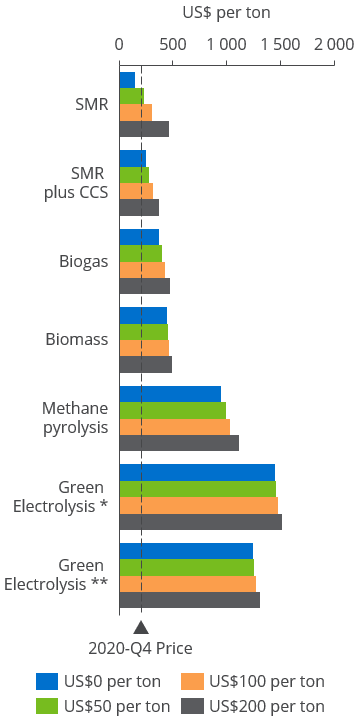Green ammonia – threats and opportunities

In order to meet climate targets, the ammonia industry will need to decarbonise and set a pathway to sustainability. Green ammonia is publicised as key to achieving carbon neutrality in agriculture as well as a key cog in the future ‘hydrogen economy’. But is there any reality in the words of clairvoyants looking into their crystal balls?
Historically, technology developments in the chemical industry have targeted cost reductions for consumers and increased capacity which has come hand in hand with global preference for barrier-free international trade and laissez-faire economics. The result – cost is first in most people’s minds and the key to success.
Most new technologies in the chemical industry are now targeting reduced emissions, reduced energy intensity, or recyclability. At times, these technologies are rowing upstream against the incumbent economic signals and movement towards a low-cost globalised economy.
Framing this in terms of Green Ammonia, the high costs of electrolysis and methane pyrolysis will result in limited success in a free market with biomass, biogas and blue ammonia seeing higher market penetration. Considering capacity, only blue ammonia can compete based on current estimates in a free commoditised market.
Three key metrics for Green Ammonia success by hydrogen source USGC, 2020-Q4
Three key metrics for Green Ammonia success by hydrogen source
Source: NexantECA * Electricity consumption estimated at 53 MWh per ton H2 and solar at 86 USD per MWh ** Electricity consumption estimated at 40 MWh per ton H2 and solar at 60 USD per MWh *** Without credits for carbon black
Long-Term Roadmap to Sustainability in the Fertilizer Industry
Opportunities for Green Ammonia
Source: NexantECA
Despite the high cost of producing Green Ammonia, there are opportunities today…
For countries that import the majority of their natural gas requirements and are key agricultural good exporters (e.g. Spain), green ammonia can be produced locally and reduce both their fossil fuel consumption and trade deficit. Spain is already very active in renewables and its sunny climate lends well to various green ammonia technologies.
Along a similar line, ‘stranded renewables’ could be exploited through the use of green ammonia. In areas with good solar or wind potential but limited local power or natural gas assets, green ammonia represents a way of monetising the renewables for use as a fertilizer or as a fuel.
There is also potential for green ammonia to be used in applications as an alternative to fossil fuels. The Japanese Chugoku Electric Power Corporation already demonstrated co-firing ammonia and coal back in 2017 with NOx emissions kept within limits. Feasibility studies are now looking at co-firing ammonia at 20 percent on an energy basis at commercial scale.
But these pathways need legislation to compensate for the higher costs of more sustainable routes. The sustainable technologies would function well if economic systems signalled for locality over commodity and sustainability over cost. Without dismantling the whole economic system which has brought improvements in living conditions to billions, legislation is required to direct consumers towards more sustainable goods. Legislation is required to encourage the switch to lower emitting technologies…
The impact of carbon taxation on Ammonia costs by hydrogen source USGC, 2020-Q4
Green Ammonia – threats and opportunities
Source: NexantECA
However, this can lead to problems without a unified and well thought out approach. The figure shows that carbon taxation will lead to higher costs for consumers excluding the status quo scenario. On the plus side, taxation levels of between US$100 – 200 per ton will improve the competitiveness of blue and green routes encouraging the switch.
Without worldwide consensus, multilateral implementation of legislation can be exploited by legislative free jurisdictions and leads to manufacturing moving away. Emissions in the EU have decreased since the implementation of the EU ETS but emissions from imported goods have increased. A border tax has been touted but raises other issues.
Finally, any new trend can lead to poor investment decisions. Carbon taxes are not necessarily used to reduce CO2 emissions further and taxpayer money may be wasted on less-than-optimal strategies.
So for legislation to encourage the switch to blue and green ammonia and a more sustainable industry, legislators need to:
1. Design roadmaps that also focus on improving soil health, sustainable farming practices and water management
2. Include farmers in discussions to help find solutions for barriers to change
3. Boost supply-driven change through incentives for sustainable products in a company’s portfolio and minimum ‘sustainably sourced’ contents per product
4. Encourage new transparent pricing signals for low carbon, carbon neutral or carbon negative goods
Find out more...
Our latest Market Analytics: Ammonia and Urea - 2020 report provides analysis and forecast to 2045 of supply and demand of the global ammonia and urea markets. This analysis identifies the issues shaping the industry as well as provide demand, supply and net trade data for 40 countries.
The Author
Daniel Saxton,Senior Analyst


